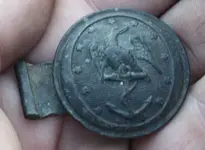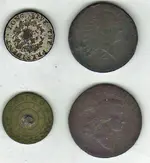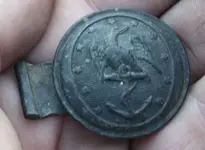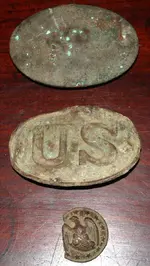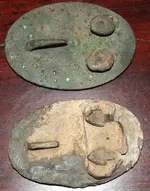johnnyi
Bronze Member
- Joined
- Jul 4, 2009
- Messages
- 1,887
- Reaction score
- 144
- Golden Thread
- 0
- Location
- new jersey
- Detector(s) used
- minelab, white's xlt, deus xp, fisher aquanaut, white's twin box
- Primary Interest:
- Relic Hunting
These are probably my best coin and button finds to date. The 1793 "wreath back" large cent I found using a whites on a property in Bucks County once frequented by Alexander Hamilton. (Near the site I also years later found a chain back, but made the mistake of washing it in water which left it looking like an unrecognizable sea sponge!) That entire property has been developed since.
The second large cent is the rare "Jefferson head" variety (about 25 known) which I found on a site which had been an Inn during and after the Rev. War. I also found a Continental Army button (Albert's G14R4) which I gave to the land owner, and which is registered in the Pa. Senate record. It was used in an attempt to stall the building of a rock quarry, but that attempt was unsucessful. My batteries had gone dead in the whites, and I used the fisher aquanaut "backup" to find this one.
The "Long Live the President" button (laurel wreath variety) is one of five to seven known, and I found this also at an Inn which was in use during the period, and which was on the route from Philadelphia to New York, the site of the innauguration. I published this find year ago in an article in the now defunct "Treasure Magazine" called "Treasures from the Plow" in which I mentioned what detector I used. I think it was the fisher or the whites. I didn't know it at the time, but there is evidence that this set of buttons was possibly made for General Monroe to wear at the innauguration. It makes sense, as the Inn was not only within sight of where he may have crossed the river, but also the area where he recouperated afterwards. This site also has been completely developed, with even the roads location moved several huindred feet to accomodate the new houses.
The last button I found a few weeks ago. It is the backmarked "Monroe" campaign button listed in Albert's as "PC75". It is by far the rarest of the four finds, with possibly two or three known that I can account for including this one. I used the new etrac with a six inch coil, after systematically skimming earth off of a 4' by 8' area to a final depth of roughly 20". The ground was loaded with square nails per square foot which made this necessary. This site thankfully has not been developed, nor will it be in the foreseable future, as I found it in my back yard.
The first buckle I found this week at a worked out foundation on the Delaware. It's the first U.S. Navy Buckle (rarity 9), The second buckle (plate) is U.S. Militia dating from 1810 which I found when the old Logan Inn in New Hope was remodeled. It had been outside the hearthstone doorway under the overhang all these years. (rarity 6.) The other two are the more common Civil War-1870 era "U.S. and sword buckles which I found buried along with a flagstaff and iron fence in the backyard of a home in Pennsylvania. They were found between the iron of a collapsed wrought iron fence along with a Civil War flagstaff which I gave to the owner. I think it may have been a memorial to a soldier who lived there, but I was never allowed to dig the fence and remove it to detect beneath for the remainig pieces. There is a piece of the belt remaining, as well as some clay I used to reinforce areas which were fragile. (rarity 1 and rarity 4 respectively)
The second large cent is the rare "Jefferson head" variety (about 25 known) which I found on a site which had been an Inn during and after the Rev. War. I also found a Continental Army button (Albert's G14R4) which I gave to the land owner, and which is registered in the Pa. Senate record. It was used in an attempt to stall the building of a rock quarry, but that attempt was unsucessful. My batteries had gone dead in the whites, and I used the fisher aquanaut "backup" to find this one.
The "Long Live the President" button (laurel wreath variety) is one of five to seven known, and I found this also at an Inn which was in use during the period, and which was on the route from Philadelphia to New York, the site of the innauguration. I published this find year ago in an article in the now defunct "Treasure Magazine" called "Treasures from the Plow" in which I mentioned what detector I used. I think it was the fisher or the whites. I didn't know it at the time, but there is evidence that this set of buttons was possibly made for General Monroe to wear at the innauguration. It makes sense, as the Inn was not only within sight of where he may have crossed the river, but also the area where he recouperated afterwards. This site also has been completely developed, with even the roads location moved several huindred feet to accomodate the new houses.
The last button I found a few weeks ago. It is the backmarked "Monroe" campaign button listed in Albert's as "PC75". It is by far the rarest of the four finds, with possibly two or three known that I can account for including this one. I used the new etrac with a six inch coil, after systematically skimming earth off of a 4' by 8' area to a final depth of roughly 20". The ground was loaded with square nails per square foot which made this necessary. This site thankfully has not been developed, nor will it be in the foreseable future, as I found it in my back yard.
The first buckle I found this week at a worked out foundation on the Delaware. It's the first U.S. Navy Buckle (rarity 9), The second buckle (plate) is U.S. Militia dating from 1810 which I found when the old Logan Inn in New Hope was remodeled. It had been outside the hearthstone doorway under the overhang all these years. (rarity 6.) The other two are the more common Civil War-1870 era "U.S. and sword buckles which I found buried along with a flagstaff and iron fence in the backyard of a home in Pennsylvania. They were found between the iron of a collapsed wrought iron fence along with a Civil War flagstaff which I gave to the owner. I think it may have been a memorial to a soldier who lived there, but I was never allowed to dig the fence and remove it to detect beneath for the remainig pieces. There is a piece of the belt remaining, as well as some clay I used to reinforce areas which were fragile. (rarity 1 and rarity 4 respectively)
Attachments
Upvote
0



